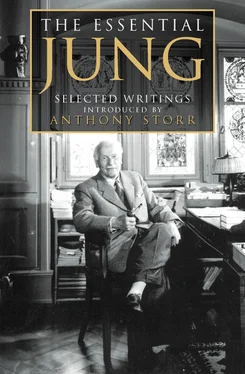So this idea has been stamped on the human brain for aeons. That is why it lies ready to hand in the unconscious of every man. Only, certain conditions are needed to cause it to appear. These conditions were evidently fulfilled in the case of Robert Mayer. The greatest and best thoughts of man shape themselves upon these primordial images as upon a blueprint. I have often been asked where the archetypes or primordial images come from. It seems to me that their origin can only be explained by assuming them to be deposits of the constantly repeated experiences of humanity. One of the commonest and at the same time most impressive experiences is the apparent movement of the sun every day. We certainly cannot discover anything of the kind in the unconscious, so far as the known physical process is concerned. What we do find, on the other hand, is the myth of the sun-hero in all its countless modifications. It is this myth, and not the physical process, that forms the sun archetype. The same can be said of the phases of the moon. The archetype is a kind of readiness to produce over and over again the same or similar mythical ideas. Hence it seems as though what is impressed upon the unconscious were exclusively the subjective fantasy-ideas aroused by the physical process. Therefore we may take it that archetypes are recurrent impressions made by subjective reactions. Naturally this assumption only pushes the problem further back without solving it. There is nothing to prevent us from assuming that certain archetypes exist even in animals, that they are grounded in the peculiarities of the living organism itself and are therefore direct expressions of life whose nature cannot be further explained. Not only are the archetypes, apparently, impressions of ever-repeated typical experiences, but, at the same time, they behave empirically like agents that tend towards the repetition of these same experiences. For when an archetype appears in a dream, in a fantasy, or in life, it always brings with it a certain influence or power by virtue of which it either exercises a numinous or a fascinating effect, or impels to action.
Jung’s conception of archetypes and the collective unconscious sprang not only from his observation of patients, but from his own experience. After the break with Freud, Jung passed through a period of mental upheaval which was so intense that he decided that he was “menaced by a psychosis.” Part of this upheaval was connected with Jung’s need to develop his own, independent point of view.
From “Confrontation with the Unconscious” MDR, p. 165/170
After the parting of the ways with Freud, a period of inner uncertainty began for me. It would be no exaggeration to call it a state of disorientation. I felt totally suspended in mid-air, for I had not yet found my own footing. Above all, I felt it necessary to develop a new attitude towards my patients. I resolved for the present not to bring any theoretical premises to bear upon them, but to wait and see what they would tell of their own accord. My aim became to leave things to chance. The result was that the patients would spontaneously report their dreams and fantasies to me, and I would merely ask, “What occurs to you in connection with that?” or, “How do you mean that, where does that come from, what do you think about it?” The interpretations seemed to follow of their own accord from the patients’ replies and associations. I avoided all theoretical points of view and simply helped the patients to understand the dream-images by themselves, without application of rules and theories.
Jung’s disturbance was also connected with something which later became a cornerstone in Jung’s delineation of the stages of life. In July 1913, Jung attained the age of thirty-eight; a time of life at which “mid-life crises” often occur. By this time, Jung had married and fathered a family, and had achieved professional recognition and a position in the world. His conscious attitude had been that, together with Freud, he could develop a new science of the mind which would benefit the world. Now, against his conscious will, his libido was being forced away from involvement in the external world into an exploration of the inner depths of his own psyche.
From “The Stages of Life” CW 8, pars. 772–7
The nearer we approach to the middle of life, and the better we have succeeded in entrenching ourselves in our personal attitudes and social positions, the more it appears as if we had discovered the right course and the right ideals and principles of behaviour. For this reason we suppose them to be eternally valid, and make a virtue of unchangeably clinging to them. We overlook the essential fact that the social goal is attained only at the cost of a diminution of personality. Many – far too many – aspects of life which should also have been experienced lie in the lumber-room among dusty memories; but sometimes, too, they are glowing coals under grey ashes.
Statistics show a rise in the frequency of mental depressions in men about forty. In women the neurotic difficulties generally begin somewhat earlier. We see that in this phase of life – between thirty-five and forty – an important change in the human psyche is in preparation. At first it is not a conscious and striking change; it is rather a matter of indirect signs of a change which seems to take its rise in the unconscious. Often it is something like a slow change in a person’s character; in another case certain traits may come to light which had disappeared since childhood; or again, one’s previous inclinations and interests begin to weaken and others take their place. Conversely – and this happens very frequently – one’s cherished convictions and principles, especially the moral ones, begin to harden and to grow increasingly rigid until, somewhere around the age of fifty, a period of intolerance and fanaticism is reached. It is as if the existence of these principles were endangered and it were therefore necessary to emphasize them all the more.
The wine of youth does not always clear with advancing years; sometimes it grows turbid. All the phenomena mentioned above can best be seen in rather one-sided people, turning up sometimes sooner and sometimes later. Their appearance, it seems to me, is often delayed by the fact that the parents of the person in question are still alive. It is then as if the period of youth were being unduly drawn out. I have seen this especially in the case of men whose fathers were long-lived. The death of the father then has the effect of a precipitate and almost catastrophic ripening.
I know of a pious man who was a churchwarden and who, from the age of forty onward, showed a growing and finally unbearable intolerance in matters of morality and religion. At the same time his moods grew visibly worse. At last he was nothing more than a darkly lowering pillar of the Church. In this way he got along until the age of fifty-five, when suddenly, sitting up in bed in the middle of the night, he said to his wife: ‘Now at last I’ve got it! I’m just a plain rascal.” Nor did this realization remain without results. He spent his declining years in riotous living and squandered a goodly part of his fortune. Obviously quite a likable fellow, capable of both extremes!
The very frequent neurotic disturbances of adult years all have one thing in common: they want to carry the psychology of the youthful phase over the threshold of the so-called years of discretion. Who does not know those touching old gentlemen who must always warm up the dish of their student days, who can fan the flame of life only by reminiscences of their heroic youth, but who, for the rest, are stuck in a hopelessly wooden Philistinism? As a rule, to be sure, they have this one merit which it would be wrong to undervalue: they are not neurotic, but only boring and stereotyped. The neurotic is rather a person who can never have things as he would like them in the present, and who can therefore never enjoy the past either.
Читать дальше












